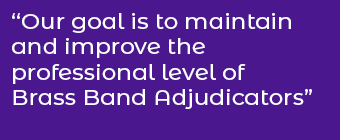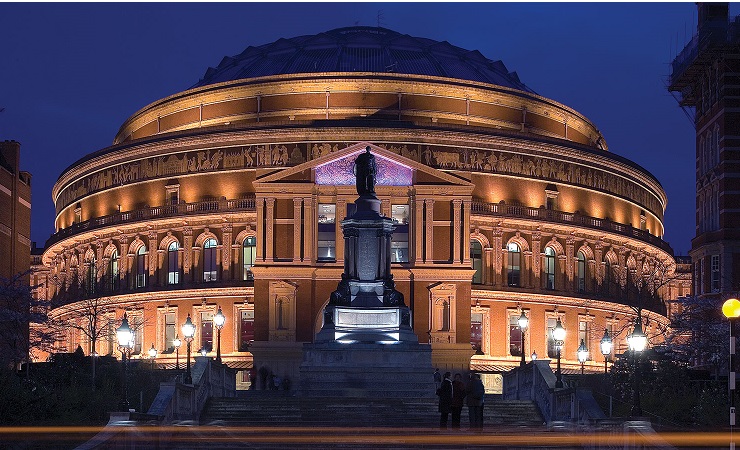
There is arguably no other major concert venue in the world as synonymous with brass banding as that of the Royal Albert Hall.
It celebrated its 150th anniversary in 2021, with the National Championships of Great Britain being held there every year since 1945 (with the exceptions of 1952 and 1953). It is an iconic London landmark as immediately recognisable, loved and revered as the Houses of Parliament.
Cake tin
Over the years it has also earned affectionate nicknames, such as the ‘Nation’s Village Hall’, the ‘Cake Tin’ or the ‘Kensington-O’, although the fondness has not always been universal.
Soon after it opened one Victorian journalist referred to it as "a monstrous cross between the Colosseum and a Yorkshire pie".
Queen Victoria was more cryptic, declaring at its opening in 1871 that; "It looks like the British Constitution". No one quite knew if she was referring to its regal status or a playful reference to her own rotund physique.
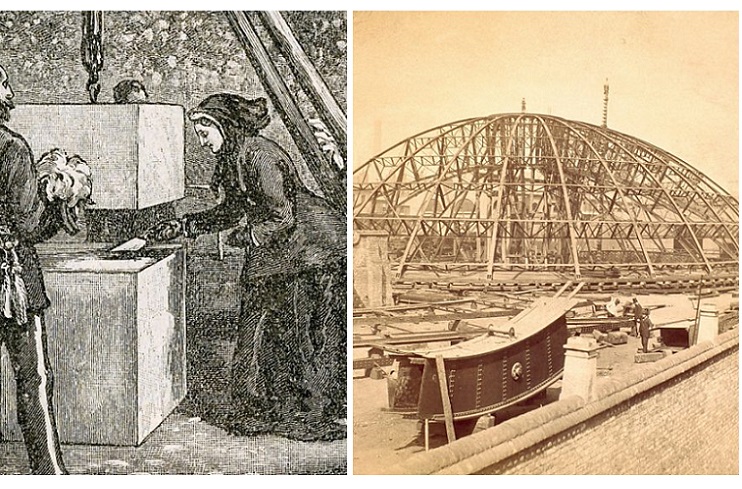
Prince Albert
Its creation was part of an ambitious plan of cultural facilities envisioned by her late husband, Prince Albert. The grand plan, fondly labelled Albertopolis, resulted in the buildings, museums and institutions that now adorn Kensington’s Exhibition Road opposite Hyde Park.
Built over a 60-year period, this was a huge undertaking in bringing the arts and sciences to the masses.
The land was purchased with the profits of the Great Exhibition of 1851 and although Prince Albert never lived to see his dream fulfilled, (he died in 1861) its symbolic centrepiece (with the Albert Memorial opposite) was named in his honour.
The land was purchased with the profits of the Great Exhibition of 1851 and although Prince Albert never lived to see his dream fulfilled, (he died in 1861) its symbolic centrepiece (with the Albert Memorial opposite) was named in his honour.
Daring scale
Its scale was daring - declared at the time to be “so far beyond any similar structure in Europe”. Its great roof is possibly still the largest unsupported glass dome in the world.
Its scale was daring - declared at the time to be “so far beyond any similar structure in Europe”. Its great roof is possibly still the largest unsupported glass dome in the world.
Originally constructed near Manchester it was taken apart before being transported by train to London to be reassembled on site (above).
Beneath it after four years of construction using more than six million red bricks, was a structure based heavily on the design of the classical ancient amphitheatre, with obvious nods to Greek and Roman sculptures around its decorated lid.
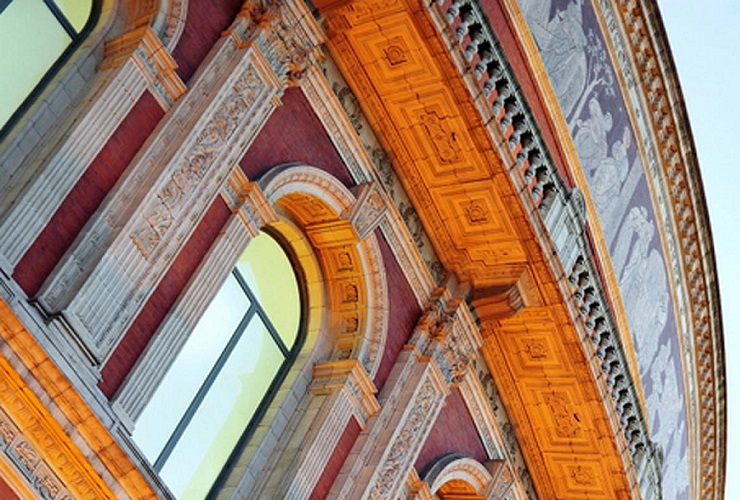
Plush grandeur
Inside, the plush red velvet interior was equally as impressive. Initially designed to accommodate up to 10,000 cramped Victorians, these days the capacity is limited to a mere 5,272.
At its far end stands the famous ‘Voice of Jupiter’ Henry Willis organ, with its 9,999 pipes (over 9 miles in total length) a crowning glory in itself – the largest pipe weighing a tonne and the smallest the size of a drinking straw.
Inside, the plush red velvet interior was equally as impressive. Initially designed to accommodate up to 10,000 cramped Victorians, these days the capacity is limited to a mere 5,272.
Art and Science
From the beginning the hall programmed ambitious celebrations of “the triumph of art and science”.
In the village hall spirit, it was intended to be “all things to all men” – accessible to the gentry and public alike and catering for all interests, even occasionally, working-class brass bands.
As a result, the subsequent 150 years have seen it host events from the emotive to the exotic, the superb to the just plain silly.
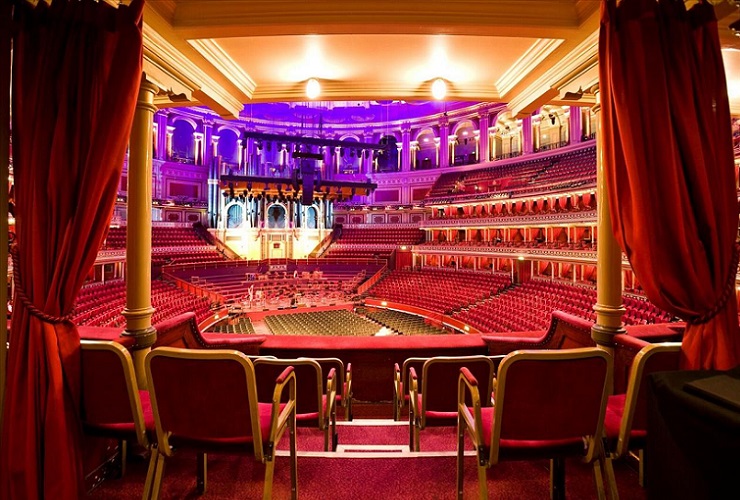
From Titanic to Daleks
In 1912 it hosted the Titanic Band Memorial Concert, whilst in 1933 Einstein gave a speech warning of looming war.
The hall has hosted the Suffragette movement (who referred to it as their Temple of Liberty), and in ironic contrast, the Miss World contest
The hall has hosted the Suffragette movement (who referred to it as their Temple of Liberty), and in ironic contrast, the Miss World contest. There have been Sumo events, tennis tournaments and boxing matches – including exhibition bouts featuring Muhamed Ali.
John Philip Sousa
The floor has been converted into an ice rink, a 600,000 litre pool, a marching arena for the John Philip Sousa Band and the world's first indoor marathon track (requiring a staggering 524 laps).
Scientific content has stretched the boundaries with events such as a mass séance to contact Sir Arthur Conan Doyle (apparently successful) and huge cos-play conferences (the first in 1871) to rival the mass geekiness of our much-loved brass band contests.
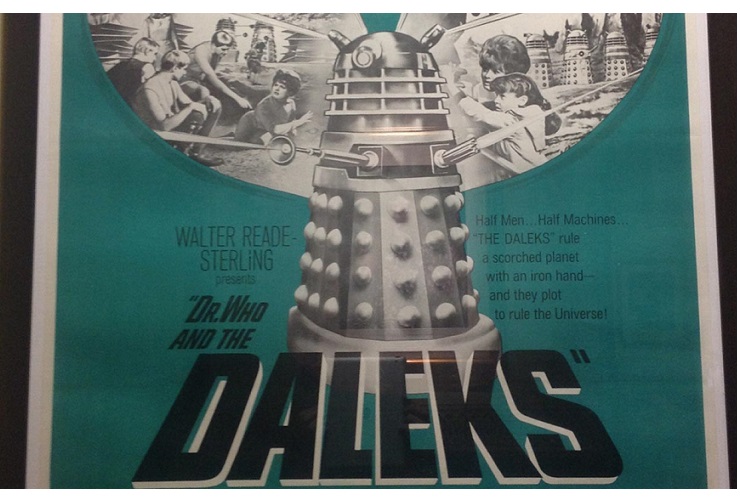
World watches
The world watches its annual Proms, and joins together for the Festival of Remembrance, whilst the legendary touts once made fortunes selling overpriced tickets to pop concert and even brass band contest goers.
For such an iconic musical venue though the acoustics have been notoriously troublesome from its very opening.
As every acoustic technician knows - the golden rule of design is simple: curved surfaces cause problems.
Golden Rule
As every acoustic technician knows - the golden rule of design is simple: curved surfaces cause problems.
The Royal Engineers’ rather experimental original design of oval floorplan and concave glass ceiling was nothing short of disastrous, and when the hall first opened in 1871 the new Prince of Wales’ opening speech was completely incomprehensible.
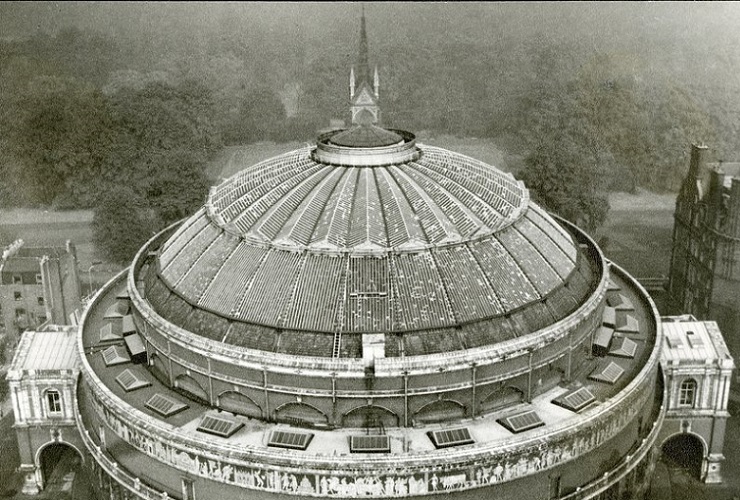
Glass dome
All this and on hot summer days the immense glass domed roof (above) also created a greenhouse effect. It was hastily covered over with a canvas awning (later replaced by aluminium panels) that remain today, though the glazing is still visible from outside.
As well as the unorthodox shape, its cavernous volume also contributed to the problem. Many musicians will be familiar with the feeling of an auditorium so intimidatingly large that the sound is comparable to playing outside, so distant are the reflecting surfaces.
Echo, Echo, Echo
The large delay of the double echo that eventually bounced back created an unnerving experience, and it used to be said that the RAH was "the only place where a British composer could be sure of hearing his work twice", such was the extent of the substantial echo, echo, echo…
The large delay of the double echo that eventually bounced back created an unnerving experience, and it used to be said that the RAH was "the only place where a British composer could be sure of hearing his work twice", such was the extent of the substantial echo, echo, echo…
The overall result is that even today the acoustics vary wildly at different points in the hall – from the contest adjudicators in the box to the sweet-wrapper grannies in the stalls and students in the ‘Gods’.
Acoustic tests were carried out in the 1870s, but the problem was not properly addressed until the 1960s.
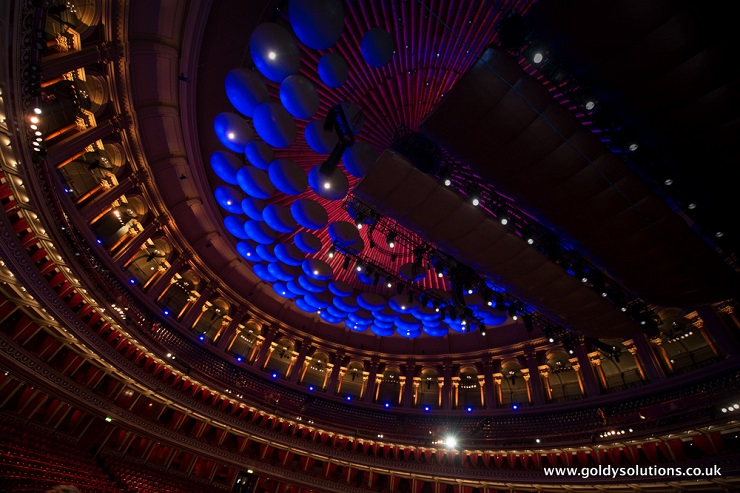
Mushrooms
The old canvas awning was replaced with aluminium panels and 135 reflectors (known affectionately as the flying saucers or mushrooms) were installed, moved and moved again.
The hall has been frequently tweaked and adjusted ever since; with innumerable acousticians trying to understand its complexities with detailed measurements, a 4-metre-long scale model (complete with barbie doll audience) and more modern detailed computer models.
Unique charm
The advances in measurement and computer prediction technology have helped to significantly improve the acoustics, but there is no avoiding the fact that it is a huge, cumbersomely curved hall, eccentric and unforgiving. Perhaps this quirk is part of its charm though.
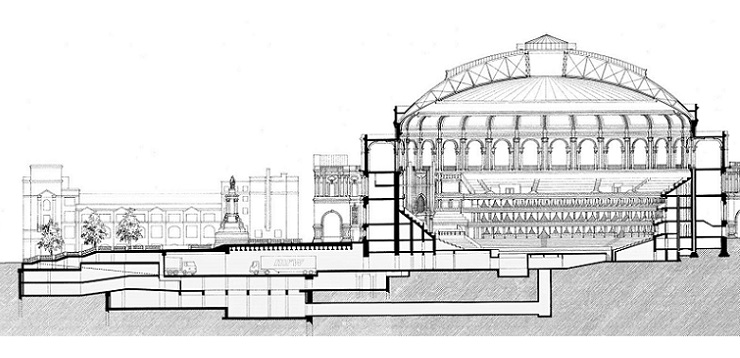
Renovations
Architecturally it has also undergone vast renovations since 1996, staggered over several years so that events could continue.
The incredible engineering included removing the famous exterior stone staircase to excavate an underground service entrance which now enables coaches and lorries to drive directly underneath.
The incredible engineering included removing the famous exterior stone staircase to excavate an underground service entrance which now enables coaches and lorries to drive directly underneath.
Vast scale
The hall does nothing on a small scale though, and the massive refurbishment masterplan included 30 vast projects to incorporate a new ventilation system, reflecting stage canopy and construction of a new south porch, each of which required terrific feats of engineering.
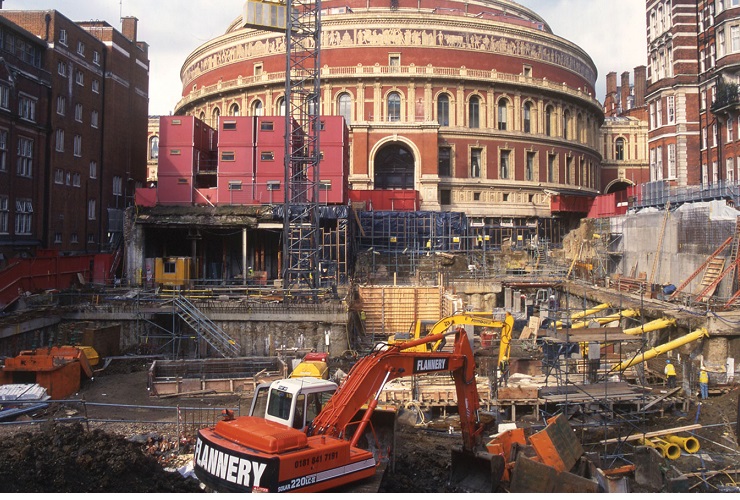
Why so special?
Given that it seems to have so much wrong with it, what is it about the Royal Albert Hall that still makes it so special then?
Despite other concert halls being more modern and shinier, none can beat its grandeur.
The feeling of the venue opening up before you step by step and that thousands of pairs of eyes from afar are directing their focus of attention right on your shoulders.
Ask any player as they walk onto its stage for the very first time. It is awe inspiring. The feeling of the venue opening up before you step by step and that thousands of pairs of eyes from afar are directing their focus of attention right on your shoulders.
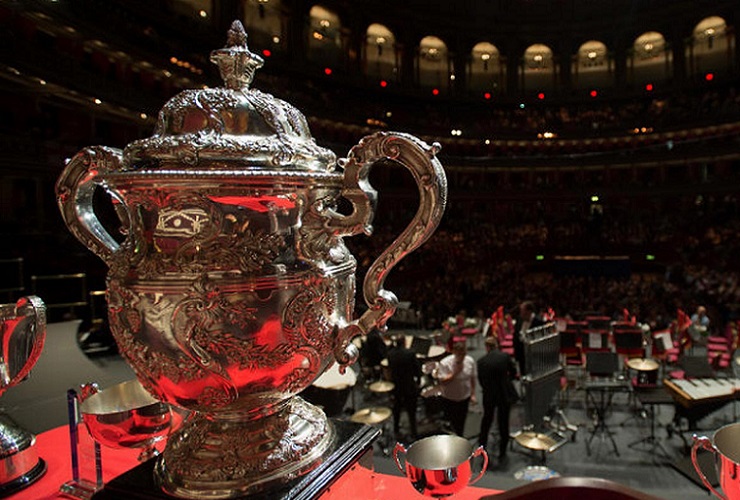
Incredible heritage
Just think who has played on the stage where you are sitting on over those past 151 years: Yehudi Menuhin (who made his debut aged just 13) and Ella Fitzgerald, Pink Floyd and Jimi Hendrix – the greatest orchestras and the finest soloists. If that doesn’t inspire you, heavens knows what will.
The Royal Albert Hall itself though has manged to become timeless.
That incredible heritage is a huge part of its appeal too. To get lost walking round the endless corridors surrounding the auditorium is to step back in time.
The Royal Albert Hall itself though has managed to become timeless.
Eccentric and historic
There is simply nowhere quite like it in the entire world, even though today it no longer throbs with passionate brass banding humanity every October as it once used to, and the ticket touts are long gone.
Somehow though it retains its majesty – imposing, awe-inspiring, eccentric and historic.
And if you have been lucky enough to perform there it will remain with you for the rest of your life.
Helen Varley
All images copyright of BDP (Building Design Partnership): Ian Clowes: Craig Chapman; 4BR










